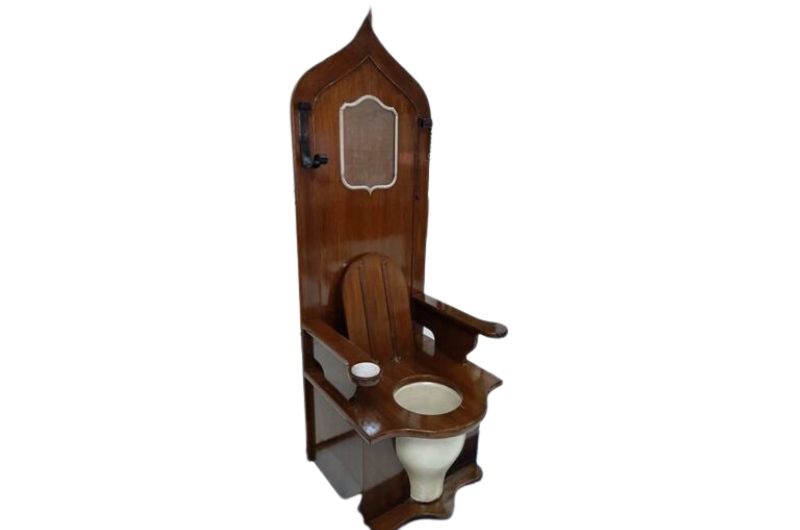An unusual museum in Delhi traces the evolution of toilets and houses a collection of trivia on this subject which most find repugnant but is crucial to personal and public wellbeing. Sarita Brara takes us on a tour
You desperately need to ease yourself, but there are no toilets in sight. And when you finally find one, your relief knows no bounds. I am sure everyone has experienced such a feeling at one point of time or the other. Well, according to Sir Park of Korea, there was no need for you to have been desperate, you could have delayed the pressure of having to answer nature’s call by simply pressing certain acupressure points on your palm with the point of a pen or pencil three or four times.
Good to know? Well, these and other tips are framed on the walls of the Museum of Toilets in Delhi. Sir Park says the Su Jok therapy could even provide relief from constipation. The museum, which houses models of a variety of toilets and commodes from over 50 countries, has lots more to impart about this not-so-pleasant subject.
It also provides tit-bits of information, such as how doctors of long ago believed that excreta had therapeutic properties. “I am surprised,” wrote one, “that God has given such important and useful and remedial powers to night soil. It is known by experience that that dung of cows stops the flow of blood from a wound and horse dung can cure pleurisy. The night soil of a man can heal wounds and remove black pustules.”

The elite in medieval France who were struck with serious diseases like the plague were reportedly taken through a sewer on a trolley. It was believed that the stench from the sewer could cure the disease. Believe it or not, according to an English poet, midwives even predicted the future of a child by examining the new born baby’s first excreta!
But to realise that there are plus-points to nightsoil, one doesn’t really have to go so far back in history – the excreta of hundreds of people using public toilets in the Sulabh International Complex, where the museum is located, is converted into biogas and used to light parts of the complex.
You may find the topics of defecating, farting and nightsoil obnoxious or nauseating, but for many they were a source of inspiration. Gill Corrozal and Piron in France and Swift in England wrote poetry on the subject. Corrozal described toilets as:
Recess of great comfort
Whether situated in the fields or in the city
Recess in which no one dares enter
Except for cleaning his stomach
Recess of great dignity
Piron calls faeces Royal Night Soil:
What I am seeing Oh God!
It is night soil
What a wonderful substance it is
It is excreted by the greatest of Kings
Its odour speaks of majesty.
It was also a subject of cartoons and humour, and examples are enshrined in one corner of the museum, the only one of its kind in India, perhaps even the world. I particularly liked the comment: ‘It is better to be pissed off than to be pissed on!’
It took three years and a lot of research to set up the museum containing pictures, and models and other exhibits that throw light on the evolution and of toilets and the social customs and etiquette related to toilets. The museum traces the history of toilets and the chronology starts from BC 2500 at Mohenjo-Daro and goes up to 1993 AD, when electric toilets were introduced in the US. Interestingly, different toilet etiquette was prescribed for married people, bachelors, students, ascetics and so on in Manusmriti and the Vishnupuran. These ancient Indian scriptures also have shlokas or couplets on how adopting the correct practice of defecation can help protect the environment.
And what a variety of models of commodes from different part of the world are on display in this museum! There are ornamental ones and ‘royal’ ones, including toilet pots made of gold and silver used by Roman emperors. The French King Louis XIV had a commode built under his throne. The museum has a replica of this too. (A court jester reportedly once said he found it strange that while the king preferred to eat in private, he chose to ease himself in public.)
There are replicas of commodes that look like books, desks and even a comfortable-looking sofa. A model of what looks like a wooden double-storeyed house turns out to be a toilet when you open the doors – the upper storey was reserved for the house owners while the lower one was for the employees. It dates back to the 1920s in the US and throws light on the status-conscious society of that time.
There are several artistically and tastefully created commodes too, decorated with etchings of colourful vines and flowers. The man behind this rare museum is none other than Bindeshwar Pathak, who is credited with starting a revolution of sorts in the field of toilets – the Sulabh Shauchalayas.
Not everyone has the luxury of being able to use a toilet in India. Open defecation is still prevalent and lot more needs to be done, not only in terms of providing toilet facilities but in changing attitudes to defecation as well. Pathak has given thousands of women a new lease of life and also dignity by liberating them from the inhuman practice of carrying headloads of night soil. But manual scavenging remains a reality and so are the deaths related to this practice.
(The writer is a senior journalist who spends parts of the year in Delhi and Shimla.)
April – June 2022



 from Webdoux
from Webdoux